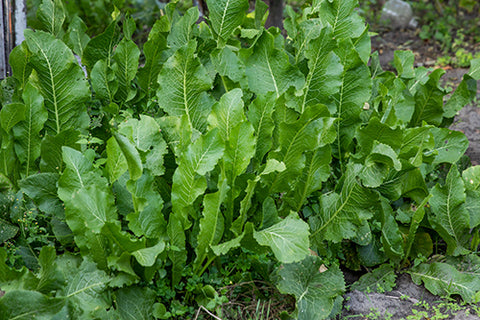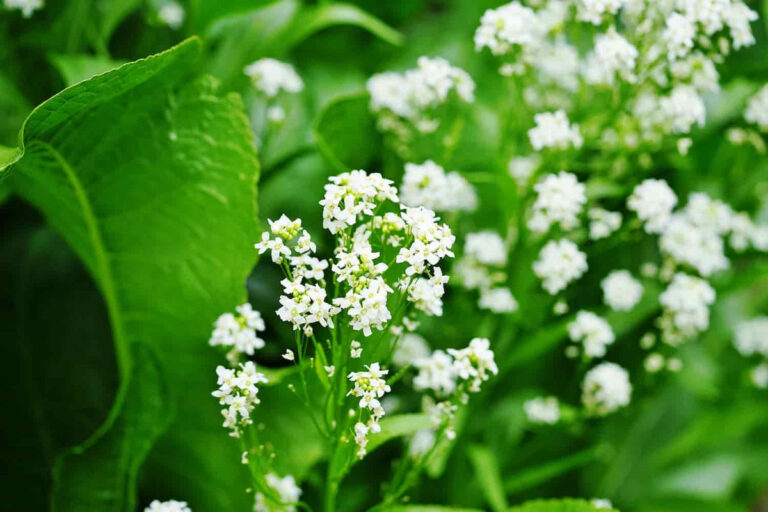Although horseradish is probably best known for its culinary role in flavoring some of your favorite dishes, horseradish, an herbaceous perennial plant, also has a long history of medicinal use.
The Latin name of horseradish, Armoracia Rusticanais strikingly beautiful – Amoracia meaning ‘near the sea’, and rustic meaning ‘of the land’. To me, this paints a clear picture of the landscapes in which these roots are cultivated. Given the unique formation of its root system, horseradish is primarily planted and harvested by hand, and 60% of the world’s horseradish is grown right here in the United States, making this plant accessible to the average American.
Horseradish botanical description
Horseradish, also called mountain radish, is believed to have originated in southeastern Europe and Asia. Horseradish can grow up to 60 cm high and 60 cm wide when ripe and has long, green, wrinkled leaves. Although the glossy leaves and white flowers are attractive, the real magic lies beneath the surface. Below ground it is very different: the white flesh of the roots is sharp, fiery and not easy to mistake. Horseradish is a member of the Brassicaceae family, along with Broccoli, Radish, Shepherd’s Purse and Bok Choy; they all have flowers with four petals in common.

If you provide full sun to partial shade, well-drained soil and plenty of water, horseradish should provide a healthy harvest. However, be careful when adding horseradish to your herb garden, as its root system can spread quickly and grow deeply, so it tends to take up more space than its intended space and can be difficult to remove.
Medicinal use of horseradish
Horseradish has a very complex nutritional profile. The roots contain a large number of nutrients such as vitamin A, vitamin C, magnesium, calcium, zinc, folic acid and phosphorus. In fact, studies have shown that one serving of horseradish contains approximately 37% of your daily value of vitamin C, making it not only delicious but also nutritious. It is best consumed fresh to retain its nutritional value. Are you looking for ways to incorporate this beneficial root into your diet? Start in the kitchen! Horseradish makes a wonderful addition to salad dressings and fresh sauces, or can be pickled to save for a later time.
You can get your daily horseradish fix by making oxymels or sweet vinegar extracts. Oxymels are an age-old folk method of using vinegar to extract medicinal components from plants. Perhaps one of the most well-known oxymels is fire cider, which combines a number of immune-supporting ingredients into a fiery tonic. Simply combine apple cider vinegar, horseradish, garlic, ginger, cayenne pepper and honey in a glass jar, cover and let sit for four weeks. Once your infusion is ready, all you have to do is strain, drink, and enjoy all the digestive and immune-supporting fire cider offers.
You can also tinct horseradish, make a cold water infusion, or simply squeeze the fresh root. Historically, a topical horseradish compress was used to support healthy levels of inflammation at the site of a sprain or similar injury.
The medicinal benefits of horseradish are quite impressive. The root provides digestive support, improves circulation, supports healthy respiratory function, and extends relief during allergy season. When taken internally, horseradish has an affinity with the sinuses, opening the pathways and potentially relieving congestion of the upper and lower airways. The root’s powerful scent can be attributed to allyl isothiocyanate, or mustard oil, which is released when the plant’s skin is broken or disturbed. Like other members of the Brassicaceae family, this compound is also found in Brussels sprouts, mustard and turnips. The warming nature of horseradish can support the removal of urine from the bladder, promoting healthy urinary function.
Peter Holmes said it best: “Horseradish root is nothing short of a restorer of innate heat.”
Horseradish: a bridge between the medicinal and culinary worlds
This medicinal plant is particularly accessible, as many are already familiar with horseradish. Herbs, roots and rhizomes with dual functions for culinary and medicinal use are very special, because they bridge the gap between these two worlds whose similarities are often overlooked. Are you new to herbal medicine? Do you like cooking and nutrition? Perhaps horseradish can be added to your routine, not only for its taste, but also for the health benefits it provides.
In Greek mythology, the Oracle of Delphi said to Apollo: “The radish is worth its weight in lead, the beet its weight in silver, the horseradish its weight in gold.”
References
- Holmes, P. (2007). The Energetics of Western Herbs: A Materia Medica Integrating Western and Chinese Herbal Therapies, Part 1 (revised, expanded ed.). Snow lotus.
- Horseradish.org. Horseradish. [Cited October 7, 2010].
Brittney Offenburg (she/her) believes in empowerment through education. She attended the Colorado School of Clinical Herbalism, where she studied medical herbalism. She is currently pursuing a Bachelor of Science in Nutrition and Integrative Healthcare at Metropolitan State University of Denver. Brittney is a Customer Journey Representative at WishGarden Herbs.
For educational purposes only. This information has not been evaluated by the Food and Drug Administration. This information is not intended to diagnose, treat, cure, or prevent any disease, or to sell any product.
Read further

